What story are you telling?

When I first started illustrating stationery and what not, I did not have a clue where I was going with it. I knew I wanted to work for myself, preferably in my pajamas, but beyond that I was just tossing spaghetti to the wall. I had no idea what my “style” was, or what anyone would even consider purchasing with their hard earned money. I was purely winging it, and I had very little cash in the bank.
This was the beauty of being childless and in your 20s.
Then eventually I made my first sale. I remember it so vividly; the sound of the caaaa-chinnnng on my phone from the Etsy app (when Etsy was cool), the way I studied the order page to make sure it was what I thought it was. The total purchase amount before shipping was $6. It was for a single greeting card that I had stamped with an image of a dodo bird on the front (???). At the time I was carving stamps of extinct animals and hand printing them on blank notecards and envelopes.

Again….truly, utterly winging it.
When I got that card ready to ship you best believe that I treated that little order like it was a precious angel. I even wrapped it in cloth (???) and tied it with ribbon (ok.). It was my fresh tiny greeting card baby who was about to be gently nudged down the tempestuous river, also known as the shipping logistical matrix, with only a hope and a dream that it would land in the correct recipient’s mailbox unscathed, and ready to bring pure dodo bird joy. I was beaming with pride.
Over time, I would begin to sell more and more things. I would move on from extinct animal motifs and try new ones. I would mostly just create whatever I felt like creating and hoped for the best reaction. The process of figuring out how to hone your unique style and mesh it with the demand of a customer is the true balancing act of having a “brand”. For a long time this is how I’ve focused my creative energy. For years I have operated in this space of “what can I make now that’s interesting and exciting for me, but also inspires someone enough to actually pay for it?”
The inevitable two toned existence of an artist trying to make a simple living.
Since I’ve been consulting with other artists and small brand owners I’ve realized all over again how invaluable it is to have an outside eye looking in on what you’re creating, especially when it comes to a branding story. While it’s true that paying for mentorship or consulting is a monetary privilege, I know from experience how much it can help clear the mind of any hangups someone might be having with their brand or product line. Even if you can’t pay for consulting, simply asking a peer (perhaps not your mother, who thinks everything you do is a miracle) to give honest and constructive feedback on your products, website, ordering experience, packaging, etc. is a practice that so many of us neglect to do. Because who wants to face criticism, even if it’s constructive? Again… it’s a practice, a valuable practice when implemented, and like any practice, the scary part tends to wane in power. When you work for yourself, the benefit of having a boss or someone who will acknowledge your hard work and provide feedback is all but missing.
An outside eye can save you years of feeling like you’re winging it.
So anywho, one of the biggest things I’ve noticed is how little energy artists and creative types tend to put into developing their brand story. Which… I get it. So much energy gets put into making the actual thing or offering that everything else surrounding it can feel like tedious extras. But I’m here to tell you, the absolute opposite is true. Yes, the thing you just made is amazing. That amazing thing also has the potential to just sit on your shelf unless you supply it with the tools it needs to find it’s forever home. One of the biggest tools is having a solid and relatable branding story that will stick in the hearts and minds of your core audience. Your brand story is what gives life to the “stuff”.
A few elements that will help define your story:
Your origin: What is your personal story? What’s motivated you to make what you make? Is there something special about your background (family history, geography, life experiences, etc) that have brought you to this point? Don’t be scared to include yourself in your story telling. Allow yourself to be a bit vulnerable. People want to know who you are because they want to connect with the person behind the beautiful things you make. We buy stories before we buy “stuff.”
Ethics & Mission: What causes are important to you? What type of mission does your brand stand by? This can range from anything from using more sustainable production methods or donating a percentage of sales to a social cause. This could also be something as simple as “I offer the best possible customer experience by… [insert action here]”. Let the people know why you are special. When you are first launching your brand you may feel a bit cloudy on what your mission and ethics are because usually you’re just trying to make those first few sales. But if you take the time to flesh this part of your story out then you will start to find the right customers who share your same beliefs, and you will gain more trust.
Archetypes & Branding: Who and/or what are the personas that are reflected throughout your brand? The rebel? The artist? The healer? Is there a hero’s journey being told? Who’s the hero and what is the challenge? Archetypes are universally acknowledged patterns of being that can come in the form of a persona, a symbol, or a storyline that has been told so many times and is so familiar that it is imbedded into our collective psyche. They are stories that we all know and understand. One simple way to figure out which archetypal energies inspire and inform your brand is to simply think of the people who inspire you or who have qualities you want your brand to emanate (can be historical figures, celebrities, people you actually know, etc.) and pinpoint some of their major characteristics. For example:
Beyoncé: Queen, goddess, femme, artist
My grandfather: Guide, warm, hard worker, proud
Frida Kahlo: Wounded hero, life & death, rebel, shapeshifter
You probably already know that your brand has an aura that exudes specific characteristics and qualities, but have you taken the time to write them down? How can you tap into those qualities and boost them to the forefront of your marketing efforts? The more clearly you define what makes your brand unique then the faster you will be able to find your particular audience.
Ways that you can use your brand’s story for seamless marketing and branding efforts (and make more sales):
Packaging that reflects the key qualities of your brand. If you want to sell your items to stores, then how your items appear on a shelf is a highly important element. If your goods are for the modern and minimalistic household then you may not want to have 5 layers of packaging and unnecessary waste. You want to make sure that your packaging and visuals are telling the right story.
An excellent About Page. Believe it or not, the About page is one of the most popular pages on a website besides Home. This is a great place to really give your best first impression and to use your storytelling skills. Start off with copy and an impactful photo focused on who your brand is for, followed by highlighting your mission and ethics, and then ending on yourself (the maker, dreamer, activist, doer, artist, whathaveyou).
Social media & blog posts related to your brand’s mission. Ever feel like it’s a total drag to think of what to post on social media? Make an ongoing spreadsheet of topics that relate to your brand’s mission, what inspires you, personal experiences, etc. and speak to your audience. There are endless topics, and content is much easier to create when you brainstorm ahead of time. Use the lens of education, observation, or reflection, and even turn to current events to make a connection with your brand’s ethics. Always recycle old content, and don’t forget to show your face. We want to see the human!
Copy writing and product descriptions that use the language and tone of your brand’s specific personality. Is it humorous? Whimsical? Direct and informative? Cheeky? Be sure to include more than just your product specs in the descriptions. I want to be able to understand the tone of your brand and I need you to tell me how this thing is going to add value to my life.
Collaborations and cross promotions with compatible, like minded brands. Collaborations can build community and create dimension to what you offer. By cross promoting with another brand you are showing how your product fits into other contexts, and it’s a great way to tap into an audience that is yet to discover you.
A common misconception when it comes to self-promotion is that people only want to see and hear about the products you’re making. This could not be further from the truth, though I am certainly guilty of thinking this way in the past. While yes, you do need to let the people know about your wonderful items that are available for purchase, the majority of marketing efforts should be centered around elements of your brand story, and that story needs to woven through your website, social channels and marketing materials. Understanding and clearly laying out what your brand is all about is one of the most important things you can do for your little business, because if you don’t know who you are and what you stand for, then I guarantee you other people looking at your brand won’t get it either. Or they’ll make their own interpretation.
This may take a little time to flesh out, but once you start to pinpoint some of the key traits of your brand, your mission, ethics, backstory, etc., you will save yourself oodles of time from trying to fit into too many boxes. By narrowing your focus you will actually open yourself up to a whole world of natural and seamless marketing possibilities that will make you feel confident and grounded in your offerings.
Your brand isn’t for everyone, but it is indeed for a special someone, and they are looking for your goods right this very minute.






Leave a comment